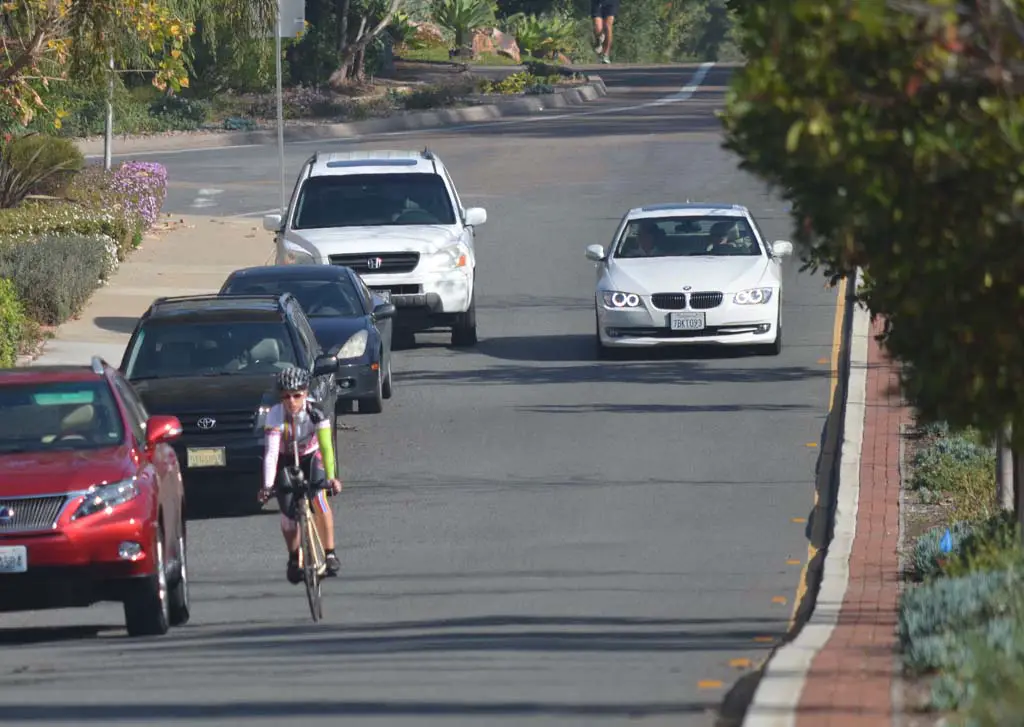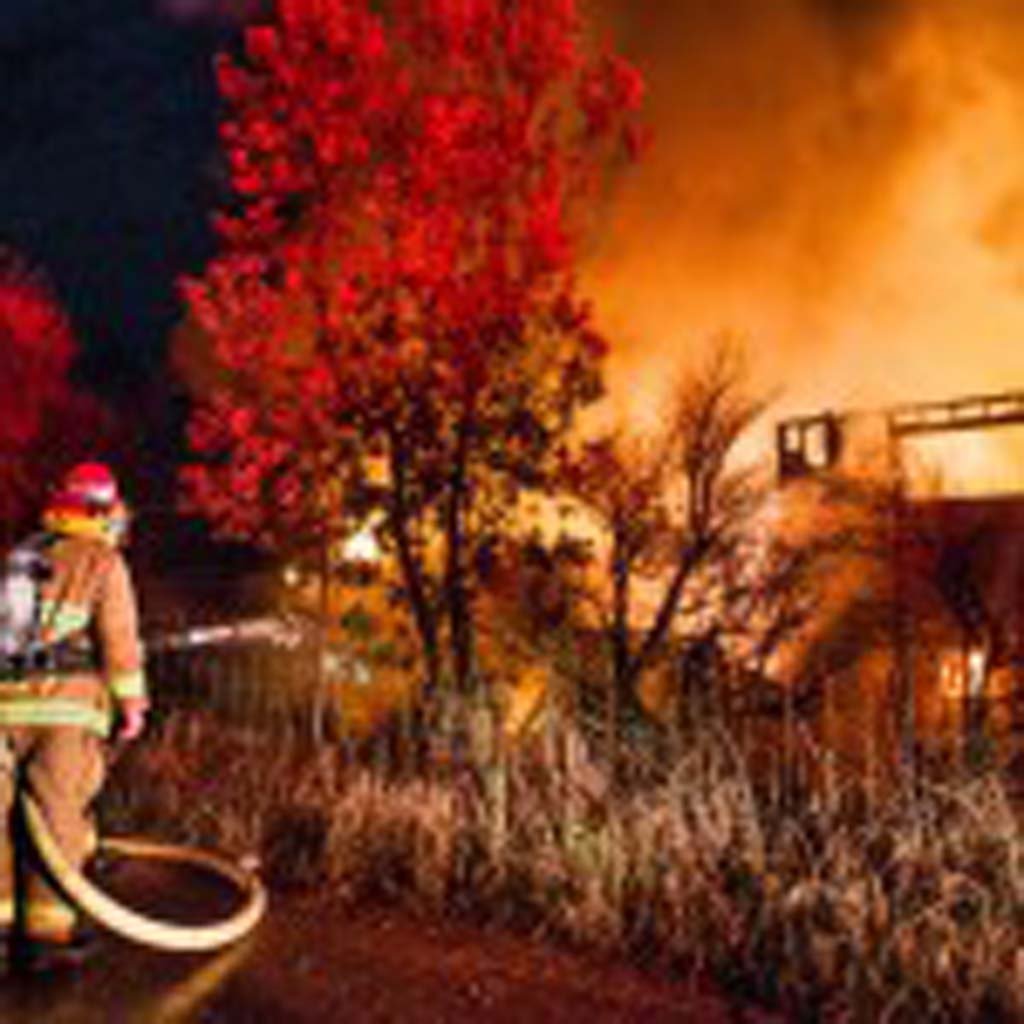CHP is increasing watch over motorist, cyclist infractions
RANCHO SANTA FE — Not until this September does the newly signed into law Three Feet For Safety Act, which is aimed at helping motorists and bicyclists to better coexist on the roadways, take effect.
But even then, around the narrow roads of Rancho Santa Fe, a motorist trying to pass a cyclist, entering into the opposite lane to do so might not be a reasonable option, said CHP Officer Jim Bettencourt.
On any given weekend, cyclists that are drawn to the diverse terrain, line the shaded and winding road ways that dissect Rancho Santa Fe.
Oftentimes, Rancho Santa Fe plays just a portion of a cyclist’s ride that can extend some 100 miles before heading out to the coastal communities of Del Mar, Solana Beach and Encinitas or further inland towards Del Dios and Escondido.
But Matt Wellhouser, chief of the Rancho Santa Fe Patrol, has said that cycling in the area has become a growing concern over the last few years for residents.
“The complaints we have received are regarding large groups of bicycle riders riding more than single file, two, three, four abreast or more. And then not stopping for stop signs,” Wellhouser said.
“One of the problems,” he said, “is the road width out here changes depending on the street. Streets like Paseo Delicias have a wider roadway and also a bike lane, whereas streets like Las Colinas or Lago Lindo have narrower lane width and no bike lane.”
The bike lanes here are deteriorated, said “Cowboy” Steve Morris, a cyclist and Encinitas-based real estate agent. “They go from six-inches to a foot, down to nothing — down to the width of the paint, with potholes and cracks and seams,” he said. “They’re not in good shape. You take some risks to be here.”
On a recent Sunday, he and a group of three other cyclists took a break from their ride, stopping for coffee and conversation at Café Positano in the heart of Rancho Santa Fe along Paseo Delicias.
Just that morning, Morris said he and his group got buzzed by motorists and honked at during their ride, even though they were in the bike lane and riding single file.
“For whatever reason, this has become a little bit of an issue lately,” Bettencourt said. “It’s becoming more prevalent in a lot of these areas. Let’s face it the weather is nice all year round…people love riding bikes in a lot of the area, especially Rancho Santa Fe.
“We just don’t have the wide shoulders for bicyclists to ride on, so a lot of times they’re in the lanes, but they’re allowed to ride in the lanes of traffic when it’s reasonable, in a lot of those areas.”
Bettencourt said that even with enforcement, the problem isn’t going away.
“At some point everybody just needs to watch out for everyone else,” he said.
Under contract with the Rancho Santa Fe Association, Bettencourt said the Association, which generally sets the guidelines for a lot of the things they want the officers to focus on, asked CHP late last fall to start enforcing the bicycle laws a little more.
He said that the CHP does have officers that are specifically out there looking for any violations involving bicyclists or motorists so it can be safer for everyone involved, though he explained that they’re not out there trying to push bicyclists out of Rancho Santa Fe.
“What we’re actually there trying to do is to make sure everybody is following the rules of the road and everybody is helping each other out,” he added.
Mike Lucas, who regularly cycles through the area, said he hasn’t noticed an increase in the amount of officers enforcing the area, but added that it was pretty easy to stay off the beaten path by taking side roads.
Bettencourt couldn’t say if they’ve necessarily increased the amount of officers in the area, but added that they’re definitely focusing on infractions regarding bicyclists and motorists that are driving unsafe around bicyclists.
“We’re definitely looking out for that in that area. They (Rancho Santa Fe residents) want us to be out there to do specifically that,” Bettencourt said.
While numbers of citations issued last year to motorists and bicyclists weren’t available by press time, Bettencourt said that he’s aware only of large bicycle groups being stopped and counseled by CHP officers, but not cited.
In some of the larger riding groups, there can be as many as 75 riders. And to cite that many for an infraction would be time-consuming.
“On average, (writing) a citation is going to take anywhere from five to 10 minutes as far as getting all of the information…you can imagine how long it would take to do that,” he said.
Morris said that riding in clubs provides almost a safety in numbers mentality.
“If they move in a unit,” Morris said, “for their own safety, that’s the safest way to go, and to actually take up the lane momentarily.”
Morris said that because of the skinny sizes of the roads, cyclists understand that there’s stress involved for cars passing one rider let alone a group.
“The car is a frighteningly strong, dangerous vehicle when it’s passing us very fast,” Lucas said.
People will continue to ride bicycles; people will continue to drive cars out there. It’s just a matter of trying to keep people safe, Bettencourt explained.




8 comments
The photograph tells a bigger story than the conflict between drivers and bike riders. If there were no parked cars, there would be room for the driver and the cyclist to get safely down that road. How did we evolve this odd hierarchy of “drivers first, then parked cars, then cyclists…”? Why isn’t the article about the very counter-intuitive sanctioned use of public roadway for storage of private property? There’s the real story.
“The bike lanes here are deteriorated, said “Cowboy” Steve Morris, a cyclist and Encinitas-based real estate agent. “They go from six-inches to a foot, down to nothing — down to the width of the paint, with potholes and cracks and seams,” he said. “They’re not in good shape. You take some risks to be here.””
Steve was misquoted. He’s not talking about bike lanes. He’s talking about shoulders. A shoulder is not a bike lane.
Under California state law, bike lanes must have bike lane signs next to them or bike lane symbols on the lane surface or both. Bike lanes must also be at least 4 feet wide if there is no gutter or at least 5 feet wide with at least 3 feet to the left of the gutter joint if there is a gutter. Otherwise, it does not comply with minimum standards required by law and bicyclists are not required to ride in it.
Under California state law, bicyclists are never required to ride on shoulders. They have a legal right to use the roadway. However, they are allowed to travel on shoulders unlike motorists. This is primarily for the benefit of motorists.
I find the CHP’s claims that their main concern is safety to be somewhat disingenuous. They have consistently shown that they don’t understand bicycle safety and frequently order bicyclists to ride in an unsafe manner such as requiring us to ride far right past driveways or intersections, which CVC 21202(a)(4) explicitly says we don’t have to do because it is inherently risky. They also seem to think that we can’t ride side by side in narrow lanes, even though CVC 21202(a)(3) explicitly exempts us from the requirement to ride far right in them. The CHP opposed the addition of paragraphs (a)(3) and (a)(4) to CVC 21202 in 1975 and 1983 respectively. In doing so, they showed that they oppose safety for bicyclists.
It sounds like Steve was mistaken, not misquoted.
Anyway, ou seem to be mistaken also, because the code you cite DOES NOT provide for bicycle riders to ride side by side. It is ONLY allowed when passing each other. In other words, they (we) do not have any special privileges on the road.
I personally choose not to ride through RSF, even though I live there. The roads are simply too narrow, and the risk of collision too high. So I drive my bicycle in the car to the coast, where the roads are wider, and often have a bicycle lane.
Chris Paul, what part of CVC 21202 prohibits bicyclists from riding side by side?
Not one thing in there prohibits riding side by side.
If any condition exempts bicyclists from the requirement to ride far right, such as a substandard width lane, which is EXTREMELY common, then bicyclists are under no obligation to ride far right. That means that they can ride anywhere that they like within the lane which means that they can ride side by side.
CVC 21202(a) ends with the words “except under any of the following situations” which means that if any of the situations in paragraphs (a)(1)-(a)(4) apply then there is no requirement to ride far right.
The law doesn’t have to explicitly allow bicyclists to ride side. It has to explicitly disallow it for it to be forbidden. I can’t help it if your reading comprehension skills are poor.
BTW, the CHP’s argument that bicyclists can never ride side by side is explicitly based upon CVC 21202 without regard to the fact that there are exceptions to the keep right requirement which cover conditions which are extremely common such as substandard width lanes. You yourself note that the lanes in RSF are too narrow. Bicyclist can use the full lane when it’s too narrow to be safe.
No keep right requirement means bicyclists can ride side by side.
As you pointed out, the law says that bicylists must ride as close to the right side of the road as safely practical except under a few conditions, such as when passing.
So if you want to pretend that you are “passing” the person you’re riding next to, you might get away with it, but you might also get killed. Especially on RSF’s narrow roads.
The CHP uses this interpretation regardless of my alleged reading skills.
CVC 21202(a)(3) reads:
“(3) When reasonably necessary to avoid conditions (including, but not limited to, fixed or moving objects, vehicles, bicycles, pedestrians, animals, surface hazards, or substandard width lanes) that make it unsafe to continue along the right-hand curb or edge, subject to the provisions of Section 21656. For purposes of this section, a “substandard width lane” is a lane that is too narrow for a bicycle and a vehicle to travel safely side by side within the lane.”
The law clearly states here that a lane where it’s too narrow to allow for safe passing distance, such as those in much of RSF, is a place where bicyclists are under ZERO requirement to ride far right.
What part of that do you not understand? It’s so simple.
One of the most basic requirements of good reading comprehension is to read all of the relevant material. Why is it that you and the CHP and the SDCS can’t read as far as paragraphs (a)(3) and (a)(4)?
Paragraphs (a)(3) and (a)(4) cover conditions which occur so frequently that bicyclists can usually use the full lane. Bicyclists usually have the right to use the full lane.
Comments are closed.